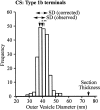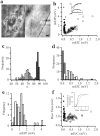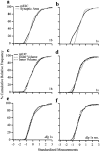Quantal size and variation determined by vesicle size in normal and mutant Drosophila glutamatergic synapses
- PMID: 12451127
- PMCID: PMC6758758
- DOI: 10.1523/JNEUROSCI.22-23-10267.2002
Quantal size and variation determined by vesicle size in normal and mutant Drosophila glutamatergic synapses
Abstract
Quantal size and variation at chemical synapses could be determined presynaptically by the amount of neurotransmitter released from synaptic vesicles or postsynaptically by the number of receptors available for activation. We investigated these possibilities at Drosophila glutamatergic neuromuscular synapses formed by two separate motor neurons innervating the same muscle cell. At wild-type synapses of the two neurons we found a difference in quantal size corresponding to a difference in mean synaptic vesicle volume. The same finding applied to two mutants (dlg and lap) in which synaptic vesicle size was altered. Quantal variances at wild-type and mutant synapses were similar and could be accounted for by variation in vesicular volume. The linear relationship between quantal size and vesicular volume for several different genotypes indicates that glutamate is regulated homeostatically to the same intravesicular concentration in all cases. Thus functional differences in synaptic strength among glutamatergic neurons of Drosophila result in part from intrinsic differences in vesicle size.
Figures







Similar articles
-
Increased expression of the Drosophila vesicular glutamate transporter leads to excess glutamate release and a compensatory decrease in quantal content.J Neurosci. 2004 Nov 17;24(46):10466-74. doi: 10.1523/JNEUROSCI.3001-04.2004. J Neurosci. 2004. PMID: 15548661 Free PMC article.
-
A product of the Drosophila stoned locus regulates neurotransmitter release.J Neurosci. 1998 Dec 1;18(23):9638-49. doi: 10.1523/JNEUROSCI.18-23-09638.1998. J Neurosci. 1998. PMID: 9822725 Free PMC article.
-
Presynaptic regulation of quantal size by the vesicular glutamate transporter VGLUT1.J Neurosci. 2005 Jun 29;25(26):6221-34. doi: 10.1523/JNEUROSCI.3003-04.2005. J Neurosci. 2005. PMID: 15987952 Free PMC article.
-
The synaptic bouton acts like a salt shaker.Cell Biochem Biophys. 2004;41(2):259-64. doi: 10.1385/cbb:41:2:259. Cell Biochem Biophys. 2004. PMID: 15475612 Review.
-
The sequence of events that underlie quantal transmission at central glutamatergic synapses.Nat Rev Neurosci. 2007 Aug;8(8):597-609. doi: 10.1038/nrn2191. Nat Rev Neurosci. 2007. PMID: 17637801 Review.
Cited by
-
Stochastic, structural and functional factors influencing AMPA and NMDA synaptic response variability: a review.Neuronal Signal. 2017 Jun 14;1(3):NS20160051. doi: 10.1042/NS20160051. eCollection 2017 Aug. Neuronal Signal. 2017. PMID: 32714580 Free PMC article. Review.
-
Synaptic vesicles: test for a role in presynaptic calcium regulation.J Neurosci. 2004 Mar 10;24(10):2496-505. doi: 10.1523/JNEUROSCI.5372-03.2004. J Neurosci. 2004. PMID: 15014125 Free PMC article.
-
Anterograde Activin signaling regulates postsynaptic membrane potential and GluRIIA/B abundance at the Drosophila neuromuscular junction.PLoS One. 2014 Sep 25;9(9):e107443. doi: 10.1371/journal.pone.0107443. eCollection 2014. PLoS One. 2014. PMID: 25255438 Free PMC article.
-
Physiologic and Nanoscale Distinctions Define Glutamatergic Synapses in Tonic vs Phasic Neurons.J Neurosci. 2023 Jun 21;43(25):4598-4611. doi: 10.1523/JNEUROSCI.0046-23.2023. Epub 2023 May 23. J Neurosci. 2023. PMID: 37221096 Free PMC article.
-
Input-Specific Plasticity and Homeostasis at the Drosophila Larval Neuromuscular Junction.Neuron. 2017 Mar 22;93(6):1388-1404.e10. doi: 10.1016/j.neuron.2017.02.028. Epub 2017 Mar 9. Neuron. 2017. PMID: 28285823 Free PMC article.
References
-
- Aoki C, Miko I, Oviedo H, Mikeladze-Dvali T, Alexandre L, Sweeney N, Bredt DS. Electron microscopic immunocytochemical detection of PSD-95, PSD-93, SAP-102, and SAP-97 at postsynaptic, presynaptic, and nonsynaptic sites of adult and neonatal rat visual cortex. Synapse. 2001;40:239–257. - PubMed
-
- Atwood HL, Tse FW. Physiological aspects of presynaptic inhibition. Adv Neural Sci. 1993;1:19–65.
-
- Atwood HL, Govind CK, Wu C-F. Differential ultrastructure of synaptic terminals on ventral longitudinal abdominal muscles in Drosophila larvae. J Neurobiol. 1993;24:1008–1024. - PubMed
-
- Atwood HL, Karunanithi S, Georgiou J, Charlton MP. Strength of synaptic transmission at neuromuscular junctions of crustaceans and insects in relation to calcium entry. Invert Neurosci. 1997;3:81–87. - PubMed
-
- Atwood HL, Karunanithi S, Wong K, Marin L, Stewart BA. Determinants of quantal size at Drosophila synapses: bouton type, vesicle size, and the size of the postsynaptic receptor patch. Soc Neurosci Abstr. 1999;25:187.11.
Publication types
MeSH terms
Substances
LinkOut - more resources
Full Text Sources
Other Literature Sources
Molecular Biology Databases
Research Materials
